PRESENTED BY MR. JOHN GEIGER FOR THE JULIAN HISTORICAL SOCIETY at the Centennial observance of the discovery of the WASHINGTON MINE ON FEBRUARY 22, 1970.
JULIAN GOLD
Julian has an alluring past–a story of Gold discovery that set off a stampede diminutive in comparison to that of 1849 in the “Mother Lode” country but still a rush for the precious metal.
In late 1869 Fred Coleman who had lived for some time around the Northern California gold fields came to herd cattle in this area. He lived with an Indian family named Nejo at Spencer Valley now known as Wynola; while riding herd one day he paused to water his horse at a little creek. A yellow sparkle caught his eye and he unpacked a skillet and began panning. For the next 30 years after that day in 1869, the history of Julian was Gold. A mining camp called Emery City was established at the junction of the two creeks. As many as 150 men washed gold from the stream bed and a few put in sluice boxes. No one made over two dollars a day. The creek was then named Coleman Creek, and a Coleman Mining Camp was organized with Coleman as the Camp Recorder. No vein or ledge was found at that time.
The Bailey boys and their cousins the Juliann’s (5 men in all) came to the area in November, 1869, and panned in the creek with no paying success. They then went to work for some settlers and did prospecting about the area; they also herded sheep.
Drury Bailey loved the area so much that he filed a Homestead claim and built a log cabin in the upper valley where Julian is today. On February 15, 1870, a mining district was formed and it was named the Julian Mining District after Mike Julian who had been elected recorder. The first quartz claim discovered in the Julian District was the Warriors’ Rost, filed by Drue Bailey and seven others on February 20th, 1870. It was a small pocket and was soon abandoned. It was located back of the present old Wellington house southeast of town on Old Cuyamaca Road.
A few days later on February 22nd, 1870 H.C. Bickers filed on the discovery of the George Washington mine. These are his words: “On February 20th, wishing to be alone I walked about 200 yards from camp. I turned and started toward camp when I noticed a track which I took for a bear track and I followed it for some distance where I came upon a group of quartz rocks, each weighing some four pounds. I picked one up and noticed free gold in it.” Hr. Bickers was an experienced prospector who had been in the northern gold fields. He showed the specimen to George Gower and to Dr. Wells, a minister from San Diego. Wells would not look at the rocks because it was Sunday, so it was set aside until the next day. Bickers continued: “the next day I took tocls starting from the spot, inviting Gower to accompany me. Upon careful prospecting we found the outcrop of the ledge. By Tuesday news got around and men began to show themselves looking for an extension of the ledge. In a highly excited state of mind Gower wrote a discovery notice commencing ‘my name, then his, then Wells. then my son, his son and relatives, and other until there were 20 people in all.”
Each person was entitled to 200 feet, making 1,000 feet in all. This Claim was filed in the Coleman Mining Camp records. The day being Washington’s birthday, Bickers, Wells, Gower and Company named it the George Washington Mine. The claim was later transferred to the Julian Mining District records. A camp was laid out by Gower, it was called Mount Vernon and was later abandoned.
The partners worked with a will and by the first of March they took 1200 pounds of ore to San Diego where 400 pounds were put in the window of Dunham’s store on 5th street for an exhibit. Crowds gathered, some seventy pounds were stolen. Excitement increased hourly.
A stampede ensued, roads were blocked and choked with men on the way to the GOLD MOUNTAINS behind San Diego. With Gold behind Emery City, “Let’s go, partner,” was the cry, “Let’s go.”
Dr. Wells stayed to look after the George Washington Mine. He was besieged by prospectors all wanting a sample of the ore. He was reluctant to give away gold ore worth hundreds of dollars a ton, so he filled up the pit and dug another some distance away.
Every prospector who came expected to find a bonanza. Discoveries of other outcrops a short distance away inflamed the camp with news and the excitement continued. There were many versions of the discovery of the Washington Nine but Bickers was official.
By August, 1870, over 54 claims were recorded in the New Julian Mining District. Drue Bailey had lain out a Townsite on his homestead and had named it after his cousin Mike Julian. The lots were 25 feet by 100 feet and Drue gave them free to anyone who would build on it. It is seldom realized that the town is “catty-wampus”, cut on a bias to Cardinal directions; to see the town-site on a map and to tramp around on its streets are two different things.
Drue Bailey looked at the terrain, saw a fairly level stretch Northwest by Southeast, that offered a space of four long blocks, and called it Main Street. Then as the trail to the Washington Mine was being rapidly worn up the hill the principal cross street was named Washington Street.
A miner was quoted in the San Diego Union of March 15, 1870, “One scarcely knows whether he is on his head or on his heels here in Julian. Imagine 800 men turned loose in the Mountains like Wild horses. A sober thought was unknown; people don’t sleep at all.”
Julian had become a wild boom town, with tents and brush shanties everywhere. Log cabins were built and many others were under construction. Four, grocery stores and twelve saloons sprang up. Prices on food and material skyrocketed. Law and order were unknown.
Five months after Bickers made the discovery he sold his interest in the Washington Mine to Gower for $5500.00. Most of the first ore mined was specimen ore that had a ready market with jewelers because it was very rich. The entire production over the years was two hundred thousand dollars. ($200,000.00)
In the late 1870’s an arrastra was built on the claim, which still stands as it was recently restored by the Julian Historical Society.
Development of the Julian mines due to the uncertain arrival of machinery, tools and supplies, the pinching out of some of the promising veins and by distraction caused by new discoveries at Banner to the east. Other problems arose between miners and Land Grant Claims if the 1870’s, the most threatening of which was the Cuyamaca Grant Claim. All of this led capital to hesitate to install expensive improvements. Money lenders were concerned about clouded titles. Then came the National Depression of 1873 and the lean years of the middle 1870’s, even though transportation had improved, and milling equipment was abundant.
After the court settlement in favor of the miners in July, 1875, things took a turn for the better and by 1380 mines were restored which had been idle. Activity increased and Julian was again a’boom town.
The decade of the 1870’s had become a reality of experiences. Very rich ore had been found on the surface at most mines. Two stamp mills were erected in the late 70’s; Wells Fargo had an office hero. They shipped $10,341.00 worth of gold in September, 1871; $5580.00 went through other sources. The price averaged $18.00.
The town population in 1871 was 500 and one hundred houses were occupied, and many small camps were also at the mines.
The spot of the original Washington discovery was on the right side of the canyon looking north. A tunnel was driven for 100 feet where another vein was encountered; both of these veins averaged one and three quarters feet wide. This vein was driven 100 feet north and 50 feet south; very rich ore was taken out of beautiful blue quartz. On the west side of the canyon a tunnel was 100 feet and ore sloped to the surface. This tunnel is now being restored by the Julian Historical Society. Further up the hill opening were made. Two shafts were sunk and a tunnel driven from the south side of the hill into these shafts; both were over 100 feet deep. In all the tunnels and drifts considerable stoning was done, indicating large production. Every thing was done by hand as no large equipment. was installed. The abaft where the windlass is Was sunk to 200 feet; because of water coming in they backed to 135 feet and drove a drift west for some 500 feet. This accounts for the large dump that is under our feet. This was the main working shaft of the 1890’s.
Mr. L.A. Smith operated the hoist on it for many years and as the years passed the quality of the ore was of milling grade and was milled in stamp mills in the area.
No records are available for the operation of the Washington Mine in the 1880’s and early 1890’s. In 1892 S.A. McDonald owned the Mine, then Issac Marks and Tom Strick. It was passed on to Henry Williams who also operated several other mines in the area. Then A.A.Sutton and A.D.Daniels took a lease from Williams in 1895.
In 1914 Williams sold his interest to Joseph Harriot for $1,000.00; Harriot had filed location notice, so Williams quit claimed. At Harriet’s passing A.B. Daniels %gain bought the mine in 1915. Daniels had-a mineral survey of the mine made.
Upon Daniels death Mr. Smith bought a one-third interest from Mrs. Daniels; another one-third interest was sold to Mr. Louis. Mr. Smith operated the mine on a share basis intermittently between other mining activities into the 1920’s. He took care of all of the assessment work and performed all necessary duties.
When Mrs. Daniels died her daughter Mrs. Barker received her interest. In 1945 the three partners petitioned for a Patent on the Washington Mine and one was issued.
Mr. Louise Smith, son of Mr. L.A. Smith, bought the other interests and became the sole ow or. The mine has been idle since 1930.
The Julian Historical Society purchased the Washington Mine from Mr. Louis Smith in 1969.
There is no doubt that the old Arrastra could tell many interesting tales of the rich ore that it ground; I was told that the floor rocks were pulled loose about 1922 and some six ounces of gold was panned out of the mud liners of the rocks. This is not unusual for so large an arrastra.

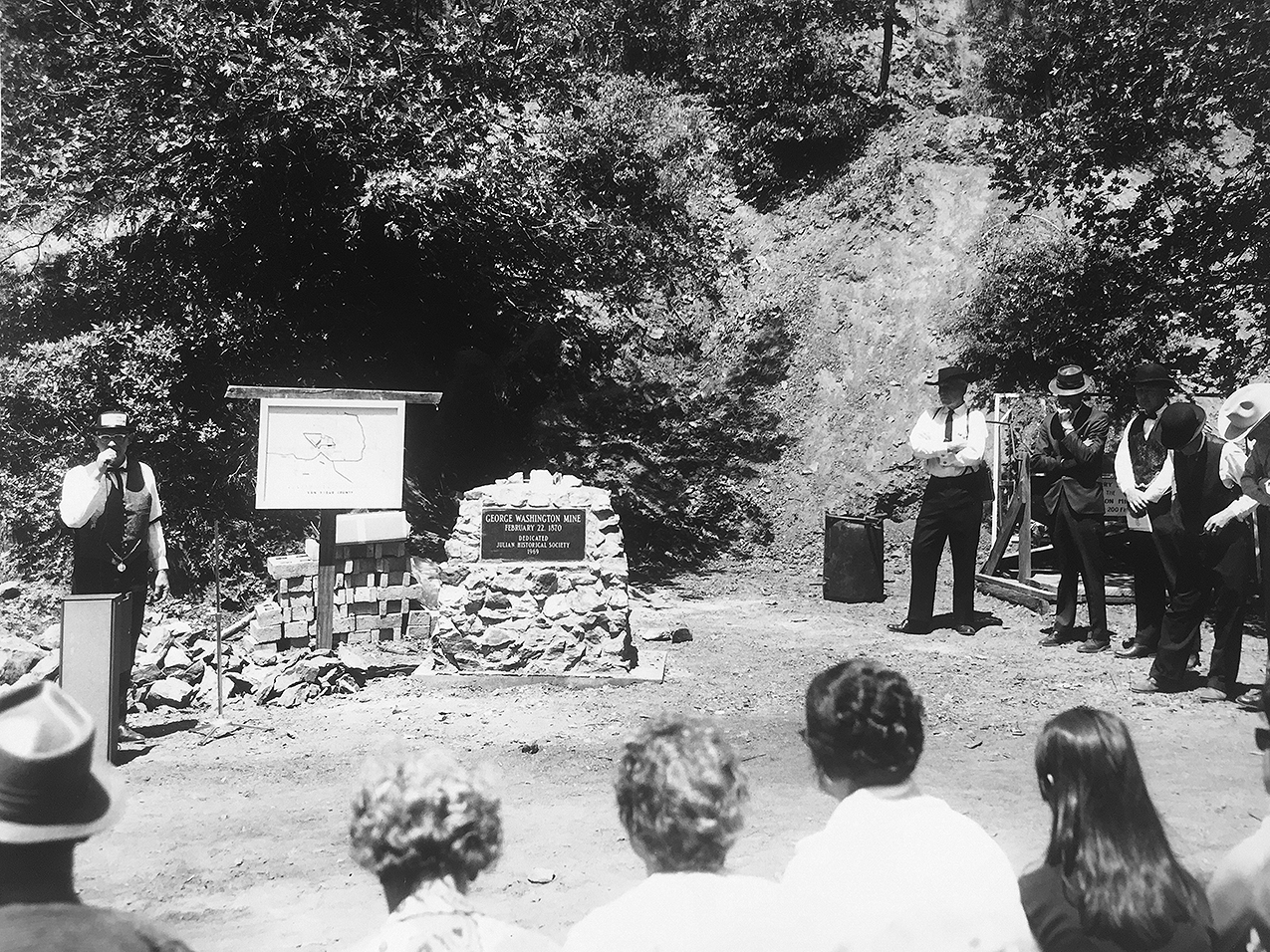

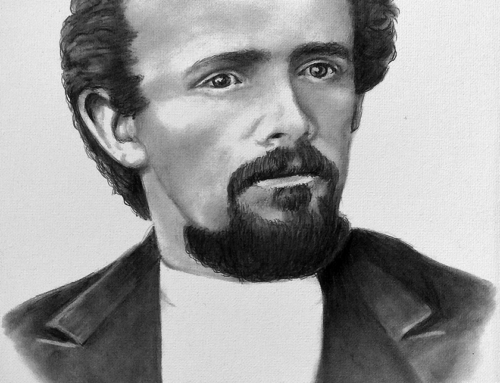
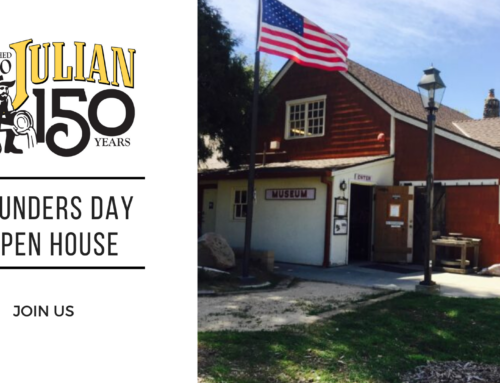
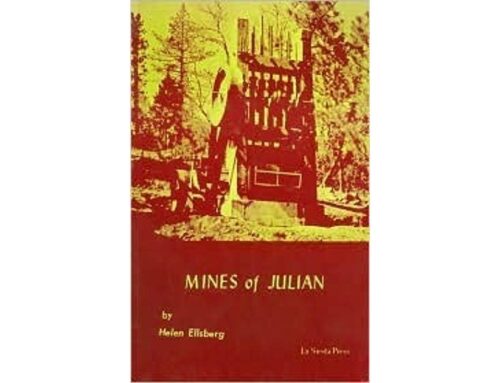
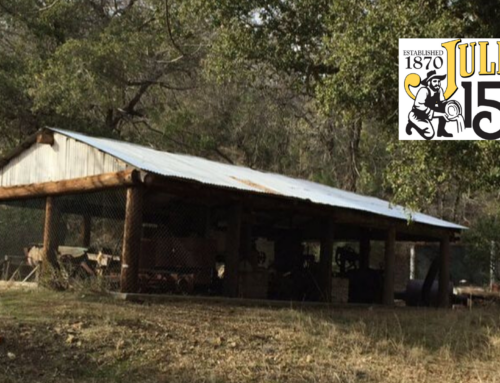
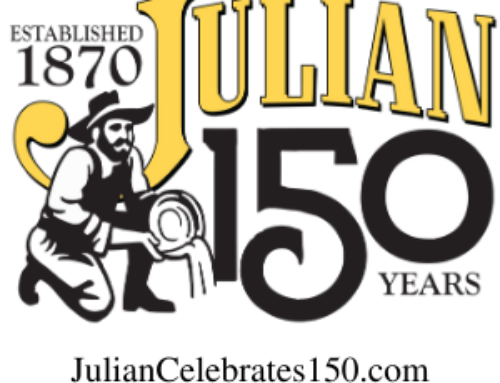
I found the story very interesting. I know my family homesteaders in the Eaple Peak area and supplied produce and fruit to the miners